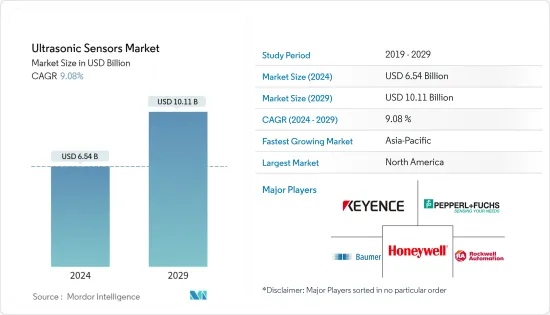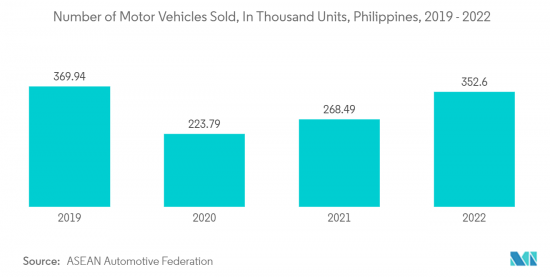 |
市場調査レポート
商品コード
1403139
超音波センサー-市場シェア分析、産業動向・統計、2024~2029年成長予測Ultrasonic Sensors - Market Share Analysis, Industry Trends & Statistics, Growth Forecasts 2024 - 2029 |
||||||
● お客様のご希望に応じて、既存データの加工や未掲載情報(例:国別セグメント)の追加などの対応が可能です。 詳細はお問い合わせください。
| 超音波センサー-市場シェア分析、産業動向・統計、2024~2029年成長予測 |
|
出版日: 2024年01月04日
発行: Mordor Intelligence
ページ情報: 英文 120 Pages
納期: 2~3営業日
|
- 全表示
- 概要
- 目次
超音波センサー市場規模は2024年に65億4,000万米ドルと推定され、2029年には101億1,000万米ドルに達すると予測され、予測期間中(2024~2029年)のCAGRは9.08%で成長します。

主要ハイライト
- 超音波センサーは、固体や液体の非接触検出に広く利用されています。これらのセンサーは、人間に聞こえる音域を超える20kHz以上の周波数で動作します。ロボット、自律誘導車、ドローンに広く使用されており、超音波センサーは様々な用途で一般的です。超音波センサーは比較的正確な測定を行い、誤差は通常1%以内です。超音波センサーは1秒間に何度も測定を行うことができるため、リフレッシュレートが速いです。さらに、希少な材料を必要としないため、通常かなり安価です。
- 自動車、医療、マシンハンドリングのような高成長分野での強化された用途の台頭と、消費者製品で勢いを増している指紋ベースの用途により、調査された市場の成長は肯定的であり、巨大な成長が予想されます。これらのセンサーは、スケールメリットに依存することで、他のセンサーよりも優れたコストパフォーマンスを実現します。
- リアルタイムの可視化能力により、センサーは標的臓器の位置を特定しながら組織生検サンプリングや治療にも使用できます。これらのセンサーは、腎臓、肝臓、膵臓、胆嚢などの内臓の診断や、妊婦の胎児の成長や健康状態の観察にも使用されます。
- クルーズコントロール、運転支援、盗難防止システムなどの自動車機能には超音波センサーが使われています。さらに、マテリアルハンドリング分野での距離測定など、さまざまな用途でも使用されています。超音波センサーメーカーは、オープン構造、防水、損傷を減らすための外部ケーシングなどの追加機能を備えた超音波センサーの複数のバリエーションを提供しています。このように、超音波センサーはADASシステムの増加が予想されるため、比例して上昇します。
- 市場は製品開発と研究を確認しています。例えば、2022年11月、Ultraleapは、メタバース向けバーチャルリアリティシステムや車載タッチレスコントローラー向けの新しい超音波センサーとトランスデューサーを開発しました。このような様々な企業や組織による取り組みが、市場における超音波センサーの需要増加に寄与すると予想されます。
- しかし、超音波センサーの検出範囲は限られているため、より広い範囲の検出が必要な特定の用途では、その有効性が制限される可能性があります。また、温度や湿度などの環境要因の影響を受けやすいなど、技術的な制約もあります。これらの制限は、センサーの読み取り値の信頼性と精度に影響を与える可能性があります。
- さらに、超音波センサーは他のタイプのセンサーに比べて比較的高価です。このコスト要因は、特にセンサーの大規模展開が必要な場合、一部の企業や業界にとっては足かせとなる可能性があります。
超音波センサーの市場動向
自動車産業が超音波センサーの大きな需要を生み出す
- 自動車の生産・販売台数の増加と顧客支出の増加に伴い、自動車産業は世界の超音波センサー市場の成長機会に貢献すると期待されています。例えば、OICAによると、2022年のインドの自動車生産台数は約550万台で、2021年の440万台から増加しています。
- アジア太平洋では自動車の販売台数が増加しています。例えば、ASEAN自動車連盟によると、フィリピンでは2022年に約35万2,600台の自動車が販売され、2021年の26万8,490台から増加しました。
- 超音波センサーは、駐車支援、安全アラーム、衝突回避、物体検知、自動ブレーキシステムなど、自動車分野でいくつかの用途を提供しています。運転支援システムや自動運転システムの開発に不可欠な役割を果たしています。
- 超音波センサーは、物体の距離を測定するためにも使用されます。長距離レーダー機能を持つこれらのセンサーは現在、車同士の衝突を回避するために自動車のクルーズ・コントロール・システムに統合されています。また、車間距離の検出、駐車支援、自動車のブレーキ制御のために後端部でも使用されています。
- これらのセンサーは、自律走行機能や高度な機能を備えた自動車の車載センシング・システムに使用されています。これらのシステムは、車両からの物体の相対距離を測定するために超音波センサーに依存しています。
- さらに、センサー・ベンダーは、開放構造、防水、損傷を減らすための外部ケーシングなど、機能を高めた超音波センサーをいくつか提供しています。このように、超音波センサーはADASシステムの増加が予想されるため、比例して需要が伸びる可能性があります。
- さらに、自動車メーカーは消費者の快適性、利便性、安全性を高めるために自動化技術を統合しています。自動運転車の普及が進み、自動車の衝突を防止するための衝突検知システムが設置されることで、世界中で超音波センサーの需要が加速すると予想されています。

アジア太平洋が市場で大きなシェアを占める
- アジア太平洋は、超音波センサー市場における主要な製造・消費国です。この地域の市場浸透率は比較的高く、いくつかの自動車メーカーや製造業大手が市場を後押ししています。
- 第13次スマート製造5ヵ年計画によると、中国は2025年までにインテリジェント製造システムを確立し、重要産業を変革することを目指しています。中国共産党は2020年の全国人民代表大会(全人代)で、「中国標準2035」と「メイド・イン・チャイナ2025」構想を倍増させるほか、デジタル・インフラ公共支出プログラムに約1兆4,000億米ドルを投じる可能性があると発表しました。
- 中国の新インフラ構想は、世界企業にいくつかのチャンスをもたらします。このため、自動車や産業などさまざまな分野での超音波センサーの採用が拡大し、同地域の市場成長を後押しすることが予想されます。
- 同地域の参入企業は製品のイノベーションに注力しています。例えば、中国福建省アモイ市に本社を置くUrsalink社は、同社のMB7380(5m)とMB7383(10m)超音波センサーを使用したIoTレベルの測定ソリューションを開発しました。Ursalink社は超音波レベルセンサーを提供しています。
- 複数の自動車メーカーと電子製品製造業が存在する日本は、市場調査にとって重要な地域です。自律走行車の配備に政府が力を入れるようになっていることも、同市場の可能性を広げると予想されます。日本の国家政策庁は、SAEレベル4の自律走行車の日本の道路での走行を妨げていた禁止措置を解除すると発表しました。この政策変更により、2023年4月から自律走行車の限定的な運行が可能になります。インドでは2025年までに40の地域で、2030年までに100以上の地域でレベル4のAVを使ったモビリティサービスを提供することを目指しています。
- Make in Indiaプログラムは、インドを製造拠点として世界地図に掲載し、インド経済を世界的に認知させる。さらに、インド政府は2025年までに5兆米ドルの経済を目指しており、そのうち製造業は1兆米ドルの価値がある可能性があります。Make in IndiaやSkill India、Digital Indiaといったフラッグシップ・プログラムの融合は、この目標を達成し、インド市場を牽引する鍵となると思われます。
- アジア太平洋には、韓国、インドネシア、台湾があります。半導体産業における大きな存在感と、半導体、電子機器、部品の製造拡大に向けた韓国の取り組みが、同国の超音波センサーの市場シェアに貢献すると予測されます。
超音波センサー産業概要
超音波センサー市場は競争が激しく、細分化されています。市場の参入企業は、革新的な製品を提供することで競合を獲得するために研究に取り組んでいます。市場の主要企業には、Siemens AG、Pepperl+Fuchs、Honeywell International Inc.、Baumer Ltd.、Rockwell Automation、Murata Manufacturingなどがあります。
- 2023年2月、PiL Sensoren GmbHは、実績のあるセンサーシリーズP47の新しいモデルバリエーションをカスタマイズしました。この高精度超音波センサーは、最大5,000mmの測定範囲において、距離測定やレベル測定などの基本的な用途に適しています。また、その音の強さにより、小さな物体も確実に検出することができます。
- 2022年2月、米国の著名な超音波センサーメーカーであるMigatron Corp.は、高速計数、液面、その他多くのプロセス制御分野のような生産ライン用途での変位測定と近接検出タスクを目的とした2つの新しいセンサーモデルを発表しました。
その他の特典:
- エクセル形式の市場予測(ME)シート
- 3ヶ月間のアナリストサポート
目次
第1章 イントロダクション
- 調査の前提条件と市場定義
- 調査範囲
第2章 エグゼクティブサマリー
第3章 市場洞察
- 市場概要
- 業界の魅力度-ポーターのファイブフォース分析
- 買い手の交渉力
- 供給企業の交渉力
- 新規参入業者の脅威
- 代替品の脅威
- 競争企業間の敵対関係
- 産業バリューチェーン分析
- 主要マクロ経済動向の影響評価
第4章 市場力学
- 市場促進要因
- 多様な産業分野での応用
- 自動車の自律安全システムに対する需要の増加
- 市場抑制要因
- 運用上の問題と技術的限界
- 高コスト
第5章 市場セグメンテーション
- 技術別
- バルク圧電トランスデューサー
- マイクロマシン超音波トランスデューサー(MUT)
- 業界別
- 自動車
- 民生用
- 産業用
- 医療
- その他業界別
- 地域別
- 北米
- 米国
- カナダ
- 欧州
- 英国
- ドイツ
- フランス
- その他の欧州
- アジア太平洋
- 中国
- 日本
- インド
- その他のアジア太平洋
- 世界のその他の中東・アフリカ
- 北米
第6章 競合情勢
- 企業プロファイル
- Keyence Corporation
- Pepperl+Fuchs AG
- Honeywell International Inc.
- Baumer Ltd
- Rockwell Automation Inc.
- Murata Manufacturing Co. Ltd
- Omron Corporation
- Sick AG
- Banner Engineering Corp.
- Balluff Inc.
- Robert Bosch GmbH
- Qualcomm Incorporated
- TDK Corporation
- Sensata Technologies
- TE Connectivity
第7章 投資分析
第8章 市場の将来

The Ultrasonic Sensors Market size is estimated at USD 6.54 billion in 2024, and is expected to reach USD 10.11 billion by 2029, growing at a CAGR of 9.08% during the forecast period (2024-2029).
Key Highlights
- Ultrasonic sensors are widely utilized for non-contact detection of solid and liquid state objects. These sensors operate at frequencies higher than 20 kHz, above the sonic range audible to humans. Widely used in robots, autonomous guided vehicles, and drones, ultrasonic sensors are common in a range of applications. Ultrasonic sensors provide relatively precise measurements, with errors usually within 1%. They can make many measurements per second, yielding quick refresh rates. Additionally, they are usually quite cheap because they do not need rare materials.
- The growth of the market studied is positive and is anticipated to grow enormously due to the emergence of enhanced applications in high-growth sectors like automotive, healthcare, and machine handling, along with the fingerprint-based application that is gaining momentum in consumer products. These sensors deliver better price performance than other sensors by relying on economies of scale advantages.
- Owing to their real-time visualization ability, sensors can also be used for tissue biopsy sampling or therapeutics while locating target organs. These sensors are also used to diagnose internal organs, including the kidneys, liver, pancreas, and gallbladder, or to observe pregnant women's fetal growth and health condition.
- Automotive functions like cruise control, driver assistance, and anti-theft systems use ultrasonic sensors. Additionally, they are also being used in various applications for distance measurement in the material handling sectors. Ultrasonic sensor manufacturers have offered multiple variants of ultrasonic sensors with additional capabilities like open structures, waterproofing, and external casing to reduce damage. Thus, ultrasonic sensors will also witness a proportional rise with the expected increase in ADAS systems.
- The market is witnessing product developments and research. For instance, in Nov 2022, Ultraleap developed a new ultrasonic sensor and transducer for virtual reality systems for the metaverse and touchless controllers in vehicles. Such initiatives by various companies and organizations are expected to contribute to the increase in the demand for ultrasonic sensors in the market.
- However, the limited detection range of the ultrasonic sensors could restrict their effectiveness in certain applications where a wider range of detection is required. They may also have certain technological limitations, like susceptibility to interface from environmental factors like temperature, humidity, etc. These limitations can affect the reliability and accuracy of the sensor readings.
- Further, ultrasonic sensors can be relatively expensive compared to other types of sensors. This cost factor might be a restraint for some businesses or industries, especially when large-scale deployment of sensors is required.
Ultrasonic Sensors Market Trends
Automotive Industry to Create Huge Demand for Ultrasonic Sensors
- With the increasing production and sales of automobiles and increased customer expenditures, the automobile industry is expected to contribute to global growth opportunities for the Global Ultrasonic Sensors Market. For instance, according to OICA, the motor vehicle production volume in India in 2022 was approximately 5.5 million motor vehicles, an increase from 4.4 million in 2021.
- The Asia-Pacific region is witnessing increased sales of automobiles. For instance, according to the ASEAN Automotive Federation, in 2022, around 352.6 thousand motor vehicles were sold in the Philippines, an increase from 268.49 thousand in 2021.
- Ultrasonic sensors offer several applications in the automotive sector, such as parking assistance, safety alarms, collision avoidance, object detection, and automatic braking systems. They play an essential role in developing driver assistance and self-driving systems.
- Ultrasonic sensors are also used to measure the distance of objects. These sensors with long-range radar capabilities are now being integrated with the cruise control systems of automobiles to avoid collisions between vehicles. They are also used at the rear end for detecting distances, parking assistance, and automobile braking control.
- These sensors are used in onboard sensing systems in cars with autonomous and advanced features. These systems rely on ultrasonic sensors for measuring the relative distances of objects from the vehicle.
- Additionally, sensor vendors offer several ultrasonic sensors with increased capabilities like open structures, waterproofing, and external casing to reduce damage. Thus, ultrasonic sensors may witness proportional demand growth with the expected hike in ADAS systems.
- Moreover, automotive manufacturers are integrating automation technology to increase consumers' comfort, convenience, and safety. The increasing penetration of self-driving cars and the installation of collision detection systems to prevent automobiles are anticipated to accelerate the demand for ultrasonic sensors around the globe.

Asia-Pacific to Account for a Significant Share in the Market
- Asia-Pacific is a major manufacturer and consumer in the ultrasonic sensors market. Market penetration is relatively high in this region, and several automotive and manufacturing giants are boosting the market.
- According to the 13th Five-Year Plan of Smart Manufacturing, China is aiming to establish its intelligent manufacturing system and transform critical industries by 2025. At the 2020 National People's Congress, the CCP announced that, in addition to doubling down on its China Standards 2035 and Made in China 2025 initiatives, it might spend approximately USD 1.4 trillion on a digital infrastructure public spending program.
- China's New Infrastructure initiative presents several opportunities for global companies. Thus, the adoption of ultrasonic sensors in different sectors, such as automotive and industrial, is expected to grow, boosting the market's growth in the region.
- Players in the region are focusing on product innovation. For instance, a Xiamen, Fujian Province, China-based company, Ursalink, developed an IoT-level measurement solution working with its MB7380 (5m) and MB7383 (10m) ultrasonic sensors. Ursalink offers ultrasonic-level sensors.
- The presence of multiple automobile manufacturers and the electronic product manufacturing industry makes Japan a significant region for the market studied. The increasing focus of governments on deploying autonomous vehicles is also expected to create scope for the market. Japan's National Policy Agency announced it would lift the ban preventing SAE Level 4 autonomous vehicles from operating on Japanese roads. The policy change will allow autonomous vehicles to operate in a limited capacity from April 2023. The country aims to offer mobility services using Level 4 AVs in 40 areas by 2025 and in more than 100 areas by 2030.
- The 'Make in India' program places India on the world map as a manufacturing hub and gives global recognition to the Indian economy. Moreover, India's government aims for a USD 5 trillion economy by 2025, of which manufacturing may be worth USD 1 trillion. The convergence of flagship programs, such as Make in India with Skill India and Digital India, may be key to achieving this goal, thereby driving the country's market.
- The other countries considered in the Asia-Pacific region are South Korea, Indonesia, and Taiwan. The substantial presence in the semiconductor industry and South Korea's efforts to increase the manufacturing of semiconductors, electronics, and components are projected to contribute to the country's market share of ultrasonic sensors.
Ultrasonic Sensors Industry Overview
The ultrasonic sensors market is highly competitive and fragmented. The players in the market are engaging in research to achieve a competitive edge by offering innovative products. Some of the key players in the market are Siemens AG, Pepperl+Fuchs, Honeywell International Inc., Baumer Ltd., Rockwell Automation, and Murata Manufacturing Co. Ltd.
- In February 2023, PiL Sensoren GmbH customized a novel model variant of the proven sensor series P47. The high-precision ultrasonic sensors are predestined for basic applications like distance and level measurements in the measuring range of up to 5,000mm. They also provide reliable detection of even small objects due to their sound intensity.
- In February 2022, Migatron Corp., a prominent USA ultrasonic sensor manufacturer, launched two new sensor models aimed at displacement measurement and proximity detection tasks for production line applications like high-speed counting, liquid level, and many other areas of process control.
Additional Benefits:
- The market estimate (ME) sheet in Excel format
- 3 months of analyst support
TABLE OF CONTENTS
1 INTRODUCTION
- 1.1 Study Assumptions and Market Definition
- 1.2 Scope of the Study
2 EXECUTIVE SUMMARY
3 MARKET INSIGHTS
- 3.1 Market Overview
- 3.2 Industry Attractiveness - Porter's Five Forces Analysis
- 3.2.1 Bargaining Power of Buyers
- 3.2.2 Bargaining Power of Suppliers
- 3.2.3 Threat of New Entrants
- 3.2.4 Threat of Substitutes
- 3.2.5 Intensity of Competitive Rivalry
- 3.3 Industry Value Chain Analysis
- 3.4 An Assessment of the Impact of Key Macroeconomic Trends
4 MARKET DYNAMICS
- 4.1 Market Drivers
- 4.1.1 Applications over Diverse Industrial Areas
- 4.1.2 Increasing demand for autonomous safety systems in vehicles
- 4.2 Market Restraints
- 4.2.1 Operational Issues and Technological Limitations
- 4.2.2 High Cost
5 Market SEGMENTATION
- 5.1 By Technology
- 5.1.1 Bulk Piezoelectric Transducer
- 5.1.2 Micromachined Ultrasound Transducers (MUT)
- 5.2 By End-user Vertical
- 5.2.1 Automotive
- 5.2.2 Consumer
- 5.2.3 Industrial
- 5.2.4 Medical
- 5.2.5 Other End-user Verticals
- 5.3 By Geography
- 5.3.1 North America
- 5.3.1.1 United States
- 5.3.1.2 Canada
- 5.3.2 Europe
- 5.3.2.1 United Kingdom
- 5.3.2.2 Germany
- 5.3.2.3 France
- 5.3.2.4 Rest of Europe
- 5.3.3 Asia-Pacific
- 5.3.3.1 China
- 5.3.3.2 Japan
- 5.3.3.3 India
- 5.3.3.4 Rest of Asia-Pacific
- 5.3.4 Rest of the World
- 5.3.1 North America
6 COMPETITIVE LANDSCAPE
- 6.1 Company Profiles
- 6.1.1 Keyence Corporation
- 6.1.2 Pepperl+Fuchs AG
- 6.1.3 Honeywell International Inc.
- 6.1.4 Baumer Ltd
- 6.1.5 Rockwell Automation Inc.
- 6.1.6 Murata Manufacturing Co. Ltd
- 6.1.7 Omron Corporation
- 6.1.8 Sick AG
- 6.1.9 Banner Engineering Corp.
- 6.1.10 Balluff Inc.
- 6.1.11 Robert Bosch GmbH
- 6.1.12 Qualcomm Incorporated
- 6.1.13 TDK Corporation
- 6.1.14 Sensata Technologies
- 6.1.15 TE Connectivity
